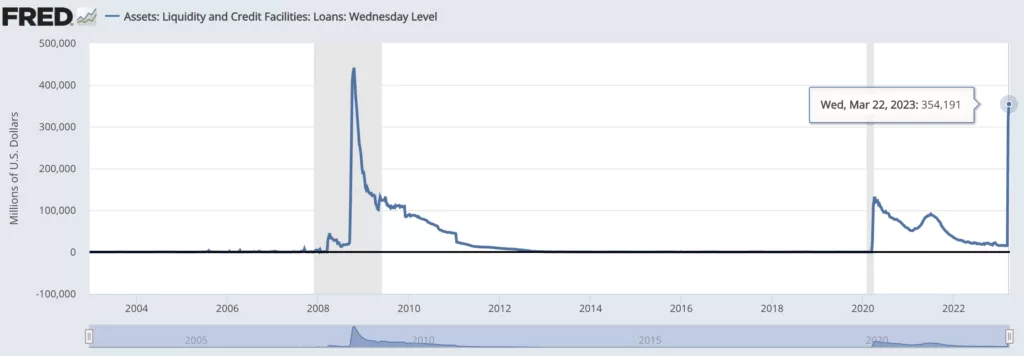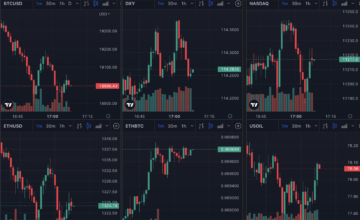The troubles in the bank markets have eased as a speculative attack on Deutsche Bank last week had many point out that the bank was actually very profitable.
But a temporary program by the Federal Reserve Banks might become a lot more permanent as banks seem to be in no rush to repay their loans.
Some $400 billion was given out by the Fed to commercial banks through repos and loans, $354 billion of it under the bank term funding program (BTFP) which values assets at the price bought, not current price.
The Fed balance sheet revealed on Thursday shows that banks still hold about as much, with just $10 billion repaid for the loans to bring them down to $342 billion.
That the sums are not increasing may be a relief, but we have to take a lot of this data on trust. There’s no audit of the Fed, no public blockchain where we can be sure of the facts. Following intense scrutiny of that balance sheet, one can’t discount accounting massages.
Taking them at face value however, while the acute part of the crisis may be over for now, a chronic stage may be developing as commercial banks might rely on what ultimately is the public to take the risk – and none of the benefits – of holding volatile assets like bonds.

BTFP is designed to allow commercial banks to hold US Treasuries to maturities, at which point they are repaid at face value.
So in simple terms, if you lent the government $1,000 on terms it is repaid in ten years, then you will get $1,000 in ten years.
That the market currently values this bond at $500 doesn’t matter in ten years because you’ll still get $1,000. And therefore the Fed is currently valuing the bond at $1,000, not at the market rate of $500.
Based on that valuation banks can get loans of $1,000, pay off the depositors as needed, and therefore in accounting terms the bond today is worth $1,000, not $500 as the market says.
A nice abstraction if you get access to it, which the public of course doesn’t, but the executives of commercial banks sit at the Fed so they’ll make their own rules that don’t care about the market.
And as long as nothing goes wrong then it should all work, but of course there’s the risk that if it becomes chronic and it increases in size, then it accumulates and concentrates risk.
To accommodate that, we’ll presumably get another massaging, but one does wonder if at some point the abstraction gets too unanchored from reality.
In addition there are questions of fairness. If commercial banks get access to this, then they should facilitate the same for the public through their bank accounts.
We might also just get rid of the secondary market for bonds as well, except there’s a catch of course because this is debt.
Those loans have to be paid back to the Fed, and with interest. If the bond market is stubborn, then can these commercial banks afford the interest for years until maturity?
And for many of these assets the bond market will be stubborn because who on earth wants a loan to the government at 1% a year for ten years when the new debt gov is issuing pays 4%.
Raising the question of whether this BTFP works only in the short term, to buy some time and to address confidence issues, as both in the medium and long term, that bond is actually worth $500.
No trickery can change that fact, even if on the surface it might seem like it does.
- SEO Powered Content & PR Distribution. Get Amplified Today.
- Platoblockchain. Web3 Metaverse Intelligence. Knowledge Amplified. Access Here.
- Source: https://www.trustnodes.com/2023/03/31/banks-keep-rolling-fed-loans
- :is
- 000
- 2023
- a
- About
- access
- accommodate
- Accounting
- Accounts
- actually
- addition
- address
- afford
- All
- and
- Another
- ARE
- AS
- Assets
- At
- attack
- audit
- back
- Balance
- Balance Sheet
- Bank
- bank accounts
- Banks
- BE
- because
- become
- becomes
- benefits
- Billion
- blockchain
- bond
- bond market
- Bonds
- bought
- bring
- buy
- by
- CAN
- Can Get
- care
- Catch
- change
- commercial
- Concentrates
- confidence
- course
- crisis
- Current
- Currently
- data
- Debt
- depositors
- designed
- Deutsche Bank
- developing
- Discount
- Doesn’t
- Dont
- down
- earth
- Even
- Except
- executives
- Face
- facilitate
- fairness
- Fed
- Federal
- federal reserve
- following
- For
- from
- funding
- get
- given
- Goes
- Government
- Have
- High
- hold
- holding
- However
- HTTPS
- in
- Increases
- increasing
- interest
- issues
- issuing
- IT
- Keep
- Last
- like
- loan
- Loans
- Long
- Lot
- make
- many
- March
- Market
- Markets
- Matter
- maturity
- max-width
- medium
- might
- more
- needed
- New
- of
- on
- ONE
- own
- paid
- part
- Pay
- pays
- permanent
- plato
- Plato Data Intelligence
- PlatoData
- Point
- price
- profitable
- Program
- public
- public blockchain
- question
- Questions
- Rate
- Reality
- relief
- rely
- repay
- Reserve
- Revealed
- Rid
- Risk
- Rolling
- rules
- rush
- same
- says
- secondary
- Secondary Market
- Short
- should
- Shows
- Simple
- Size
- So
- some
- Stage
- Still
- sums
- Surface
- Take
- temporary
- ten
- terms
- that
- The
- the Fed
- their
- Them
- therefore
- These
- Through
- time
- to
- today
- too
- Treasuries
- Trust
- Trustnodes
- Ultimately
- under
- us
- us treasuries
- Valuation
- value
- Values
- valuing
- volatile
- webp
- week
- WELL
- What
- whether
- which
- while
- WHO
- will
- with
- Work
- works
- worth
- Wrong
- year
- years
- zephyrnet












